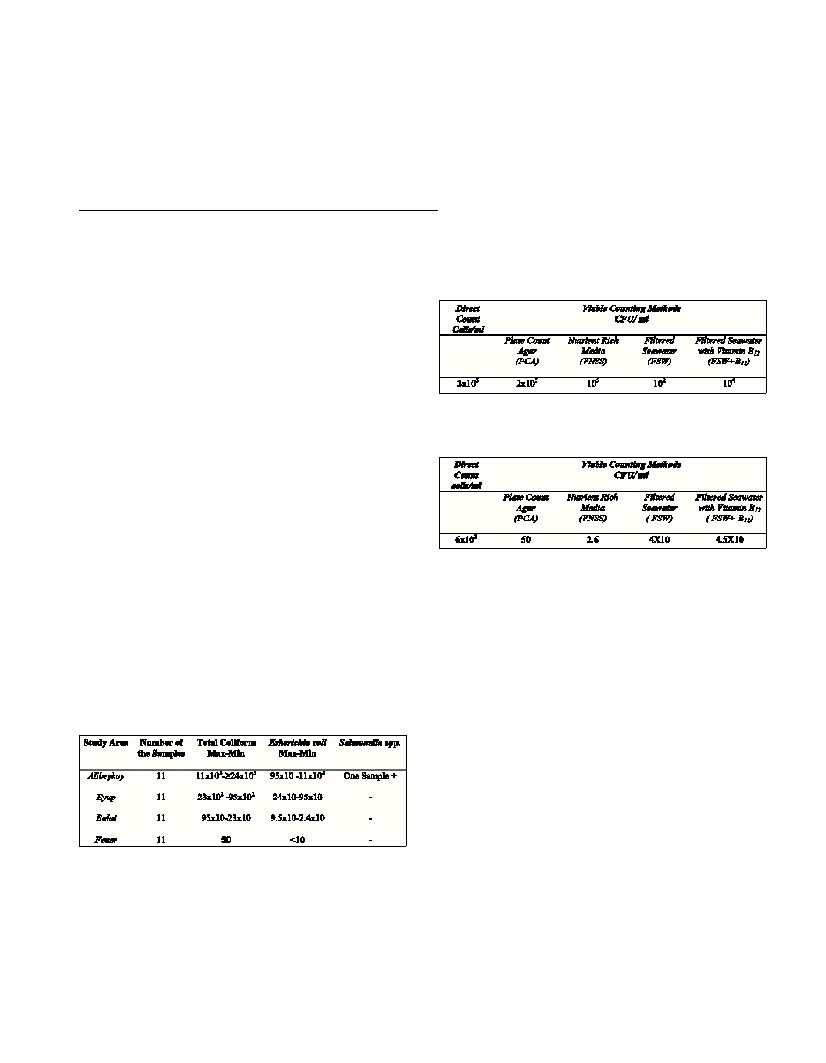THE COMPARISON OF BACTERIAL LEVEL IN THE GOLDEN HORN (ISTANBUL, TURKEY) BY
USING MICROSCOPIC AND CULTURAL METHODS
Gülsen Altug
1*
,
Yunus Bayrak
2
1
Istanbul University, Faculty of Fisheries, Istanbul, Turkey - * galtug@istanbul.edu.tr
2
Ministry of Agriculture and Rural Affairs, Istanbul, Turkey
Abstract
Surface water taken from four different areas in the Golden Horn (Istanbul, Turkey) was analyzed in order to detect levels of bacterial
contamination. Bacterial densities enumerated by direct microscopic counts were 2 orders of magnitude higher than plate counts.
Key words: Microscopic Count, Viable Count, Bacterial Contamination
Rapp. Comm. int. Mer Médit., 37,2004
260
Introduction
Bacteria play a central role in the bio-cycles in aquatic
environments (1). Under anthropogenically induced eutrophication,
bacterial abundance might increase and pathogenic bacteria might be
present as well (2) in?uencing human health (3).
Instead of conducting separate tests for pathogen bacteria, like
Salmonella, Esherichia coli 0157, Vibrio cholera,determination of
indicator bacteriausing ordinary analytical methods is a classic
approach in aquatic microbiology (4, 5). When we count marine
bacteria using either microscopic or ordinary viable counting me-
thods, great differences often occur between direct counts (DC), and
viable counts on nutrient rich media such as ZoBell 2216E and VNSS
(6).
Golden Horn has been one of the important recreation areas of
Istanbul (Turkey) but became heavily polluted in the last half of the
20
th
century.
Materials and methods
A total of 44 samples of surface water was collected from the
coastal area of Alibeykoy, Eyup, Balat and Fener (Golden Horn,
Istanbul) and transported to the laboratory between November 2002
and September 2003.
Bacterial counts were made using direct microscopic counting
techniques (DC) and the Most Probable Number (MPN) Technique
with different media. VNSS agar plates (800 mg C/l), Plate Count
Agar (PCA), 0.22 µm Filtered Natural Seawater (FSW), Filtered
Seawater with 0.05 µg/l vitamin B
12
(FSW+B
12
) were used for viable
counts (6; 4). After 24 hours of incubation at 37
o
C colonies on agar
plates were counted.
Results
The results of bacterial counts using DC and cultural methods on
surface water samples collected from Golden Horn during the
investigation period are given in Tables 1-3. Total Coliform and E. coli
were highest in samples taken at Alibeykoy (Tables 1, 2). Maximum
bacterial abundance was detected by direct microscopic counting.
Minimum bacterial numbers were detected using Filtered Seawater as
the medium.
Table 1. Analysis for Total Coliforms, Esherichia coli, and Salmonella
spp. in surface waters from Golden Horn, Istanbul, Turkey (MPN/100mL)
Discussion
Microscopic counting of bacteria in samples from Alibeykoy
yielded 3x10
5
cells/ml, values of the same samples on Plate Count
Agar were 2x10
5
CFU/ml. Variances in bacterial counts in samples
from Alibeykoy were found to be lower as compared to samples
collected from Fener (Table 3). Samples from Fener showed that
differences between microscopic counts and cultural counts are
greater in oligotrophic environments. As can be seen in this study,
both the trophic level of the aquatic environment and the different
enumeration methods used affect the results of the counts. Thus,
studies on transforming unculturable bacteria to culturable forms are
important (6; 7; 8). It is assumed that bacteria undergoing sudden
exposure to nutrient rich media cannot utilize the substrates (9).
Table 2. Bacterial counts by microscopic and viable counting meth-
ods in surface water collected from Alibeykoy (Golden Horn, Istanbul)
Table 3. Bacterial counts (cells/ml) by microscopic (MC) and viable
counting methods in surface water collected from Fener (Golden Horn,
Istanbul)
References
1-Heissenberger A., Leppard G.G., Herndl J.G., 1996. Relationship
between the intracellular integrity and the morphology of the capsular
envelope in attached and free-living marine bacteria. Appl. Environ.
Microbiol.,62: 4521-4528.
2-Jacob J.M., 1989. Safe Food Handling World Health Organization
Genava 142.
3-Ducklow H.W., Carlson C.A., 1992. Oceanic bacterial production. Adv.
Microb. Ecol.,12: 113-181.
4-APHA, American Public Health Association, American Water Work
Association,Water Environment Federation, 1998. Standard Methods for
the examination of water and waste water (20th ed) Clesceri, LS.,
Greenberg, A.E., Eaton, AD, EDS. Washington.
5-Bordner R., Winter J., Scarpino P., 1978. Microbiological methods for
monitoring the environment: water and wastes. Environmental Monitoring
and Support Laborotory, Office of Research and Development. EPA-
600/8-78/017
6-Eguchi M., 1999. The nonculturable state of marine bacteria. 8
th
International Symposium on Microbial Ecology, Bell CR, Brylinski M,
Johnson-Green P (Eds) Canada.
7-Pinhassi J., Zweifel UL., Hangström A., 1997, Dominant marine
bacterioplankton species found among colony-forming bacteria. Appl.
Environ. Microbiol.,63: 3359-3366.
8-Schut F., Prins R.A., Gottschal J.C., 1997. Oligotrophy and pelagic
marine bacteria: facts and fiction. Aquat. Microb. Ecol.,12: 177-202.
9-Bloomfield S.F., Steward G.S., Dodd C.E.R., Bototh I.R., Power
E.G.M., 1998. The viable but non-culturable phenomenon explained?
Microbiology, 144: 1-3.

